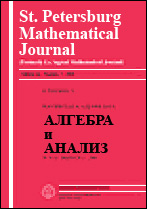|
Research Papers
On the derivative of the Minkowski question-mark function for numbers with bounded partial quotients
D. R. Gayfulin
Institute for Information Transmission Problems of the Russian Academy of Sciences (Kharkevich Institute)
Abstract:
It is well known that the derivative of the Minkowski function ?(x) may take only the values 0 and +∞ (provided it exists).
Let En be the set of irrational numbers on the interval [0;1] whose contitued fraction expansion has all convergents of at most n.
It is known also that the quantity ?′(x) at the point x=[0;a1,a2,…,at,…] is related to the limit behavior of the arithmetic mean (a1+a2+…+at)/t.
In particular, as was shown by A. Dushistova, I. Kan, and N. Moshchevitin, if for x∈En we have
a1+a2+…+at>(κ(n)1−ε)t,
where ε>0, and κ(n)1 is a certain explicit constant, then ?′(x)=+∞. They also showed that the quantity κ(n)1 cannot be replaced by a greater constant.
In the present paper, a dual problem is treated, specifically, how small the quantity a1+a2+…+at−κ(n)1t may be if it is known that
?′(x)=0/ Optimal estimates in this problem are deduced.
Keywords:
fraction, continuant, Minkowski function.
Received: 14.12.2021
Citation:
D. R. Gayfulin, “On the derivative of the Minkowski question-mark function for numbers with bounded partial quotients”, Algebra i Analiz, 34:5 (2022), 23–52; St. Petersburg Math. J., 34:5 (2023), 737–758
Linking options:
https://www.mathnet.ru/eng/aa1830 https://www.mathnet.ru/eng/aa/v34/i5/p23
|


| Statistics & downloads: |
| Abstract page: | 145 | | Full-text PDF : | 1 | | References: | 33 | | First page: | 24 |
|





 Contact us:
Contact us: Terms of Use
Terms of Use
 Registration to the website
Registration to the website Logotypes
Logotypes









 Citation in format
Citation in format 